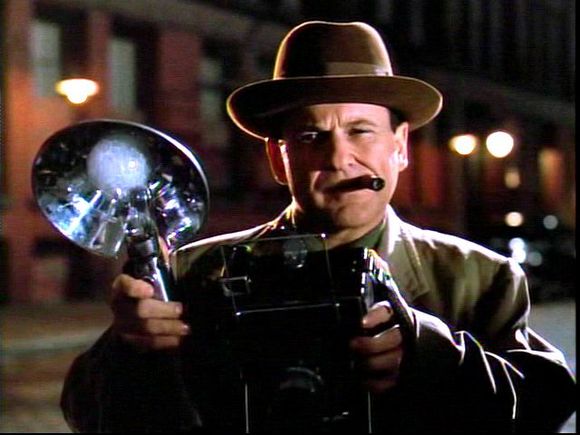The Public Eye
In his commentary for DAZED AND CONFUSED, director Richard Linklater describes that interesting thing that happens when you watch a period movie that was filmed years after the era depicted. Years later, if the film succeeds in that most important of tasks - the atmosphere - it may seem as if it were actually filmed in its time. DAZED, so carefully constructed, does indeed feel like it was shot in the mid 70s, even though it was actually filmed in 1992.
THE PUBLIC EYE, also from '92, is set in the 1940s in that wonderful movie world of neon saturated windows and sidewalks and drifting smoke, and feels very much a part of its time. Director Richard Franklin and his crew have done a superb job of creating a movie in which you could just get lost and wander around. I have found myself doing that with several "immersive" movies, walking away from the central action when it becomes tedious and absorbing the landscape. AVATAR is a perfect example, even though it was patently artificial, unlike THE PUBLIC EYE, which was shot mainly on Chicago streets (and set in NYC).
If the film feels like a '40s programmer, it has characters and a storyline to match. Leon "Bernzy" Bernstein (Joe Pesci) is a natural figure in this shadowy world: a Big City tabloid photographer who captures the most astonishing photos. Often at crime scenes, usually of the deceased. He's always there at just the right moment: the assailants having made their escape and the Law yet to arrive. Is he psychic? Like the real life figure Bernstein is based upon: Arthur Fellig, or "Weegee" so named as the police thought the guy had a Ouija board to account for his perfect timing? In the movie, the answer is simple: Bernzy has a police scanner in his apartment that he monitors constantly.
No would-be noir is complete without a questionable "skirt". Barbara Hershey plays Kay, a widow and nightclub owner who enlists Bernzy's help to investigate mob types who've been threatening her. Seems Kay's late husband was indebted to them or, something. Bernzy, a lonely shlub, is immediately smitten with the striking woman and agrees against his better instincts. Things quickly get thorny and soon the Feds are interrogating. Bernzy gets a good man killed. There's a restaurant massacre before the credits roll. Familiar James Cagney territory.
The relationship between Bernzy and Kay is well drawn and thoughtful, right through to the film's conclusion. Unlike in GOODFELLAS, Pesci's previous film, his character has a conscience and a heart. In one of his few leading roles, he makes a favorable impression, a minor leap from the character parts he does so well. We're a little sad for him as he watches soldiers kissing their girlfriends in bars and on street corners, clutching and dipping them like in that famous war time picture everyone's seen. Both actors play their caricatures well, even as Hershey's low cut dresses threaten to upstage her in nearly every scene. And thankfully, unlike in CASINO, we are spared a Pesci love scene.
Franklin paces the film just right. Well modulated are dialogue and action scenes, cut into each other near seamlessly. There are amusing stylistic jolts: sometimes bloody violence and sometimes repeated shots of flashbulbs literally popping like bullets out of Bernzy's camera. But the setting is the key element, and if you love to sink into yesteryear urban melodramas, you're almost certain to enjoy this, even though you'll probably forget it all the next day.



Comments